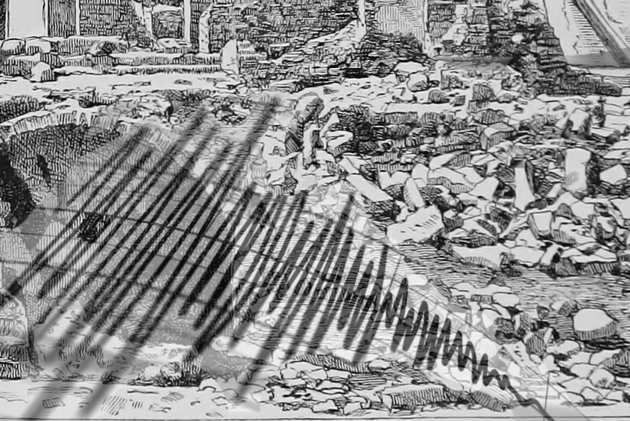The region has been hit by some of the worst quakes in the world, including in the same areas of Turkey and Syria struck on Monday A major 7.8 magnitude earthquake hit south-east Turkey and northern Syria on Monday, killing at least 2,300 people and wounding thousands more.
The Middle East has suffered a large number of quakes across the centuries, including some of the worst recorded instances in history. Monday’s quake impacted the Hatay province of Turkey, as well as provinces in northwest Syria - areas which have previously suffered two of the deadliest earthquakes in the world. Iran, Palestine and Egypt have also been devastated by earthquakes, damaging historic buildings and killing tens of thousands in the process.
1138: Aleppo, Syria
The earthquake which struck Syria’s Aleppo on 11 October 1138 was one of the worst earthquakes in history. The disaster is believed to have killed around 230,000 people, according to the 15th-century Egyptian-Islamic historian, Ibn Taghribirdi. It occurred in an area of northern Syria lying between the Arabian and African tectonic plates. Aleppo’s citadel completely collapsed, while a Muslim fort at al-Atarib (now part of modern-day Aleppo province) was also levelled, killing 600 of the city’s guards. At the time, Aleppo was subject to upheavals due to battles between Muslim forces and Crusaders. The Crusader Citadel at nearby Harem, which lies in the modern-day opposition-held Idlib province of Syria, was flattened. The huge earthquake was the first of many to devastate areas of northern Syria and western Turkey between 1138 and 1139.
856: Damghan, Iran
The 856 Damghan earthquake in northern Iran was also one of the worst natural disasters in global history. On 22 December 856, a major quake of magnitude 7.9 and intensity X (the maximum level on the Mercalli intensity scale) struck in the Alborz mountain area of Iran. It is thought to have killed around 200,000, though the figure is disputed. The US Geological Survey lists it as the sixth deadliest earthquake in recorded history. The city of Damghan was significantly destroyed, as well as several areas surrounding it. Damghan was the capital of the medieval Persian province of Qumis until it was destroyed in 1723. Iran lies between the Arabian and Eurasian plates, which frequently collide, resulting in devastating earthquakes.
526: Antioch, Turkey
A deadly 526 earthquake struck the then-Byzantine city of Antioch, which lies in the Hatay province of modern-day Turkey. The quake was caused by Antioch’s location directly atop a convergence of three tectonic plates: the African, Arabian and Anatolian. The same convergence resulted in Monday’s quake in Hatay province. In the natural disaster, 250,000 were killed, according to some estimates. Many of these deaths were not a result of the initial quake, but of a series of fires that broke out following the earthquake. The magnitude was likely to have been 7.0, according to modern estimates. The Domus Aurea, a large octagonal church, was among the prominent buildings destroyed by the resulting blaze. Some researchers believe that the huge death toll may have been due to Antioch hosting a yearly Christian festival of Ascension Day, drawing travellers from across the Byzantine Empire. Emperor Justinian, who took to the Byzantine throne a year after the quake, spent large sums of money rebuilding the city. It was to no avail, as the city was sacked by the Persians just over a decade later.
1033: Jordan Valley, Palestine
The 1033 earthquake in the Jordan Valley in Palestine devastated swathes of the Levant region. The quake was between 6.7 and 7.1 magnitude, according to most scholars, and killed at least 70,000 people. The disaster has been linked to the Dead Sea rift, a series of fault lines between the African and Arabian tectonic plates which have caused many earthquakes in the last two millennia. The cities of Nablus, Jericho, Hebron, Tiberias, Ashkelon and Akka were destroyed in historic Palestine. A mosque was destroyed in Gaza, while walls and churches were damaged in the old city of Jerusalem. Hisham’s Palace, a major early Islamic site in Jericho that is still visited to this day, was destroyed. Damage was also reported in parts of Syria and Egypt. According to historical records, the destruction followed a similar pattern to an earthquake in 749 in Galilee, which killed tens of thousands.
1754: Cairo, Egypt
Tens of thousands of people were killed in a devastating earthquake in Egypt’s Cairo in 1754. The earthquake, estimated to be 6.6 in magnitude, is believed to have resulted in 40,000 deaths in the-then Ottoman Empire city. A huge number of buildings in Cairo collapsed, killing many residents. Parts of the City of the Dead, an area of Islamic-era necropolises and cemeteries in Cairo, were destroyed. Saint Catherine’s Monastery in the Sinai peninsula, now a Unesco World Heritage site, was also damaged and subsequently repaired.






